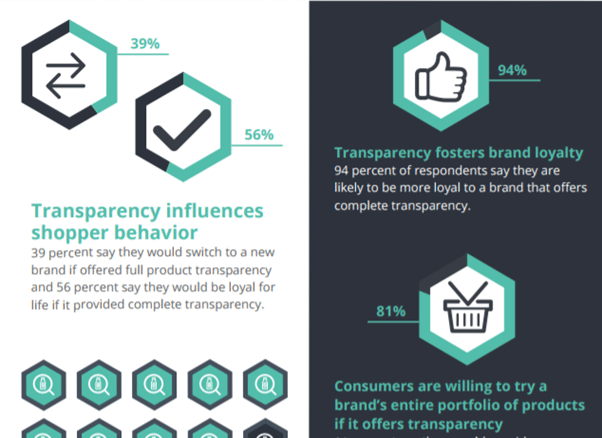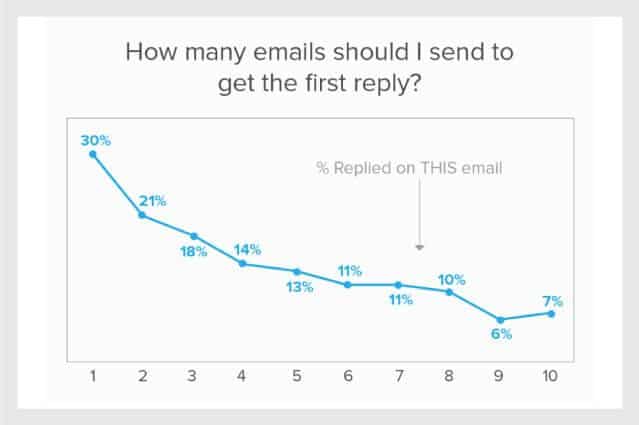You’ve just received a negative review on Google. Or maybe, you’ve just decided to focus on improving your digital reputation and discovered some critical reviews of your business. Either way, a negative review on Google is a problem you need to address.
The consequences of negative reviews can be devastating to a business.
Just consider the last time you looked for a restaurant with curbside delivery. Almost subconsciously, you automatically skip places with low ratings or negative reviews.
This problem is not unique to you. 9 out of 10 consumers conduct online research before making a purchase, and almost 40% of people will not purchase from a business with less than four stars.
Take a moment, take a breath, and digest those figures. You can read them a few times if you need to.
The reality of reviews is real, and the importance Google reviews play in the world today, especially to small businesses, has never been more relevant.
However, enough of the doom and gloom. All is not lost. Sit back, pay attention, and learn how to effectively deal with negative reviews on Google.
Take a moment before responding
You have to respect the power a customer holds online. The internet seems to be written in permanent ink sometimes.
Seeing a negative review about our business can damage our psyche, make us feel defensive, and elicit pure anger. We’ve all had moments where our emotions get the best of us. Reacting in the heat of the moment can feel satisfying, especially when you think the feedback is not warranted.
But is it in the best interest of your business? It’s probably not the right decision to rail off an unfiltered attack on your upset customer.
Not only is it poor customer service to berate your unhappy customers, it can also have a negative impact on your brand. And thanks to social media, you can never be too sure where the story will end up. Take the story of this restaurant owner who reacted to a customer’s complaint about the cost of lemon water.
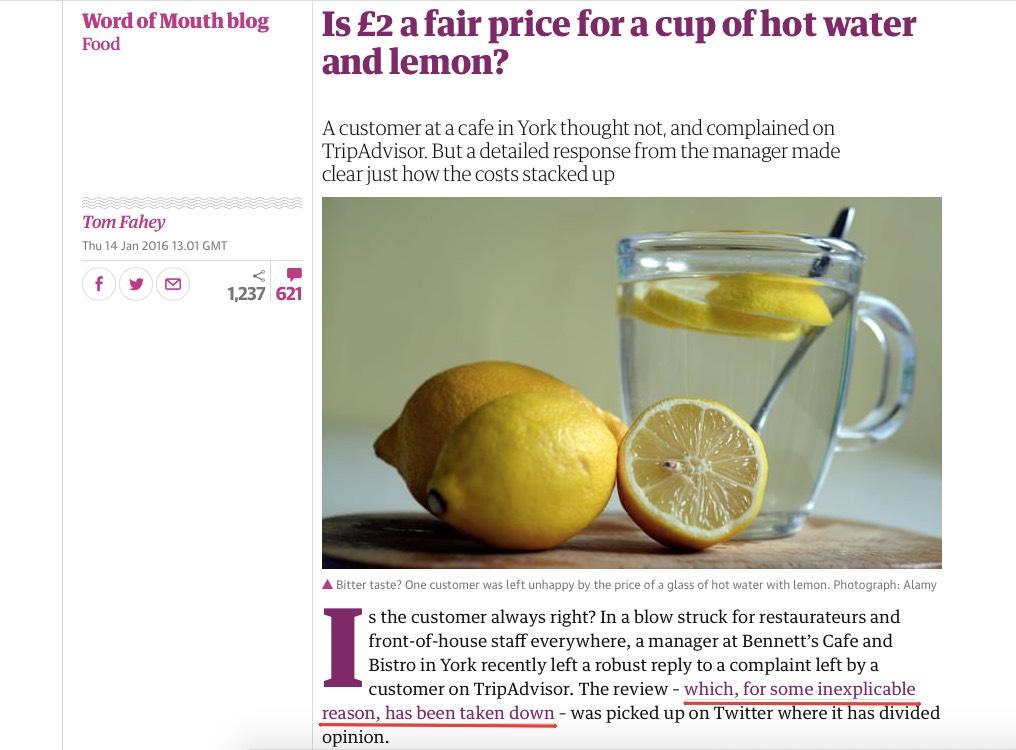
While the proprietor certainly had a point, the story ended up in a British national newspaper. Rather unsurprisingly, the feedback was taken down, but the genie was already out of the bottle.
Before you respond to a negative review, calmly assess the situation and consider your response. One way to help overcome the desire to react emotionally is to create some template responses.
Start the process of creating a negative review response template, by considering the most likely complaints you are likely to get. Then, while you’re feeling calm, create some templates.
Hi [Reviewer name],
My name is [Your name], and I’m the [Your position] at [Your business].
I am so sorry about the [a brief mention of the complaint]. That’s not how we want to run our business and we’d like to make it right.
Please reach out to me directly at [your personal business email address] and we can set up a time a chat to find a solution.
[Signature]
In the event that you were able to make things right at the time, it’s valuable to highlight to the reviewer as well as show other potential customers how you took care of their complaint. Here’s a template you could use in that situation.
Hi [Reviewer name],
My name is [Your name], and I’m the [Your position] at [Your business].
I am so sorry about the [a brief mention of the complaint]. The last thing we’d want to do is make you feel [appropriate feeling – angry, upset, disappointed].
Here’s how we plan on making this right:
- [Solution 1]
- [Solution 2]
- [Solution 3]
I look forward to your return and exceeding your expectations next time.
[Signature]
Here are some examples of negative review response templates that you can use. Template responses are especially important for large companies. A template can help standardize the company response. But remember, always customize your templates. If it’s obviously a template, that could make the matter worse.
Respond to every negative review on Google
Whether the review is bad or good, always respond publicly. You want to know why?
A Harvard business review study discovered that businesses who responded to all their reviews, even the negative ones, saw an improvement in their ratings. This could be because customers mitigate their negative feedback when engaging with another person.
Moreover, by responding to a bad review publicly, you are showing as a business owner, you are willing to learn from your mistakes in an open environment. Taking responsibility for your mistakes is what the customer ultimately wants. Well, most customers.
An even more recent Harvard study found that responding to negative reviews quickly will appease the customer more quickly. That might make it more likely for the customer to change their bad review to a positive one.
Provide transparent customer service
Transparency with your online community will work wonders for your business going forward. Research shows 85% of Americans are more willing to back a company that has a history of being transparent with their customers.
Being transparent means receiving feedback and taking appropriate action to remedy the problem. People notice if a business is replying with a template response, but not taking any action to solve the problem.
Unsurprisingly, a study carried out by Label Insights revealed that 94% of respondents are more likely to be loyal to a brand that is transparent in its dealings with customers. You should aim to be that company.
Sometimes, however, a negative review isn’t clear. In cases like this, it’s important to ask appropriate questions. Once the problem is highlighted, a savvy solution can be provided.
Provide a personal touch
Remember that golden rule, “Treat someone how you’d like to be treated yourself?”
Well, bear that in mind when responding to a negative Google review, regardless of your emotions.
Empathy and effort need to be displayed until the customer is satisfied. Something as little as signing off the response with your name shows the customer you aren’t a robotic business machine. It brings a touch of humanity to the situation. Showing you are engaged emphasizes that you’re invested in their feedback.
If you can resolve the customer’s complaint, be sure to ask if they’d be prepared to change their original review. A person updating a review to show that you try your best to provide a good service speaks volumes about your company. Furthermore, it can help push your ratings up.
How to improve your online reputation
Okay, so now we have given you our top tips on combating negative reviews you should be aware of the importance of maintaining a stellar reputation. However, if you’re still not convinced, we have found a survey that reinforces the importance of a positive reputation.
Research conducted by the Temkin Group found that people tend to share their customer experiences with others, pretty normal right? Well, remarkably, the tendency to publicly comment on a business is stronger when the experience is negative.
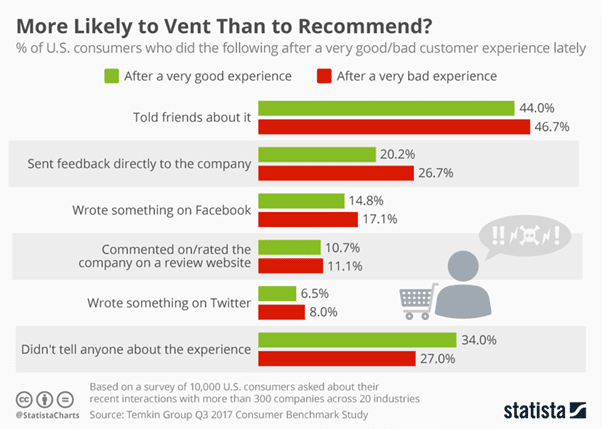
According to the same research, 34% of respondents shared a positive experience they had with a company. Meanwhile, 73% of people shared a negative experience with friends and other people.
Bad Google reviews can be avoided, but the chart displays some interesting statistics on how the human psyche works when dealing with a complaint against your business.
The solution to improving your overall score, therefore, is to actively generate positive reviews from your customers. The way you achieve this will depend on the type of business you are operating. Generally, though, all tactics revolve around the basic idea of asking satisfied customers for a review. This should be incorporated into the customer journey.
You’ve probably received reminders and requests from various companies you have interacted with. Take Airbnb, for example:
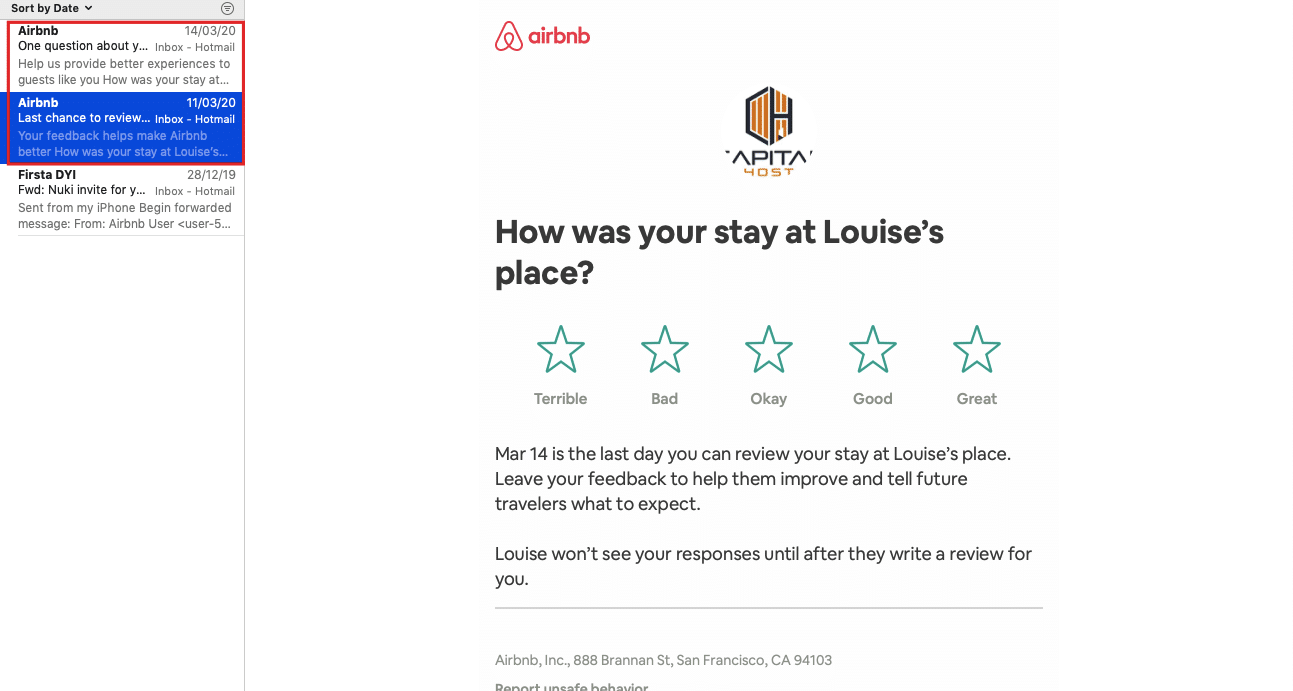
A few months ago, before the pandemic, I used the app to book accommodations. Everything about the experience was great. Like just over a third of happy customers, I didn’t initially talk share my positive experience using their service. But…Airbnb sent me two reminders asking for feedback.
After some significant prodding, I decided to leave a review.
While the context is slightly different, the graph below nicely illustrates why sending multiple follow up emails helps you get a response. It’s common sense that sending out 10 emails is probably overdoing it a bit.
If you plan to use this approach to generate positive reviews for your business, you will need to make some email templates asking for a review. This active approach to managing your digital reputation should help you improve your overall rating. This is important as review sites play a role in customer acquisition.
Wrapping up
If your business is receiving consistent negative reviews, it means it’s time for a change. It’s not something you can ignore, so use it as a learning experience. The best thing you can do for your company to reduce the negative reviews on Google is to focus on providing the best service.
When it comes to reputation management, make sure to engage with feedback on the customer review channels that matter to your business. Secondly, put a system in place to ask for positive feedback from satisfied customers. Providing great service and engaging with your satisfied customers is the best way to maintain a stellar online reputation. However, it’s almost inevitable that you will receive some negative reviews.
When you do receive a negative review, don’t react immediately. Remain cool, and use negative review templates for feedback if necessary. Hopefully, by following the tips shared in this article that one-star sinking feeling in the bottom of your stomach will become a distant memory.


